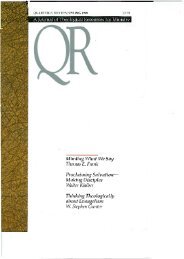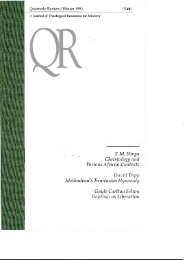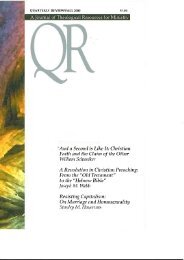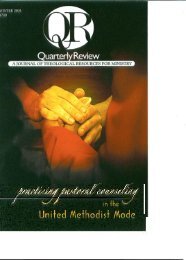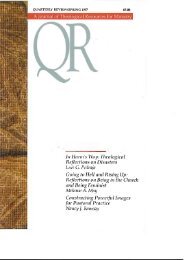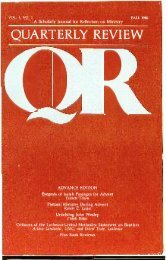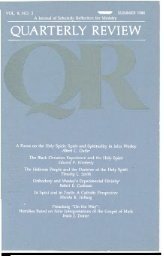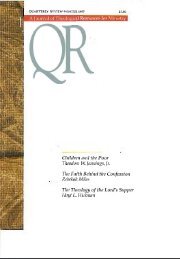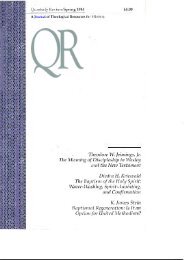Winter 1984 - 1985 - Quarterly Review
Winter 1984 - 1985 - Quarterly Review
Winter 1984 - 1985 - Quarterly Review
Create successful ePaper yourself
Turn your PDF publications into a flip-book with our unique Google optimized e-Paper software.
HOMILETICAL RESOURCES<br />
according to God's Word in the present and future. As the community<br />
recognized that it required renewal for its present and future, it<br />
inquired of and sought a link with its past. The act of interpreting the<br />
past for the needs of the present—that was and is midrash. When<br />
interpreters sought in Torah for communal standards, rules, and law,<br />
they created halakic midrash, interpretations to produce or support<br />
law. When they searched Torah for theology, spiritual values,<br />
religious principles, ethics, consolation, even entertainment, they<br />
created aggadic midrash or homilies.<br />
One should not be misled into thinking that the interpretational<br />
activity described above was dedicated to the pursuit of a progressive<br />
uncovering of the plain meaning of ancient texts or traditions. That<br />
was the work of commentators and translators, and the Jewish people<br />
have produced such people. But the midrashists' work was<br />
something else. They saw their task as making the text and tradition<br />
live in the midst of the community. Hence, as they searched and<br />
inquired of the past's legacy, perhaps a verse, or part of a verse, or<br />
even a single word of the tradition might, as it were, leap from the<br />
page to provide for the need of the day. The element that provided for<br />
the community's sustenance was used for that purpose. Inevitably,<br />
this meant that issues of conformity to the text's "plain meaning,"<br />
though significant, were not primary, and sometimes they were<br />
simply overlooked. The "preacher of Dubnow," R. Jacob Kranz<br />
(nineteenth century), described the process as one of making arrows<br />
appear to have hit the bull's eye by painting targets around them. That<br />
view rightly indicates that Jewish homilies have been most significant<br />
when our teachers found the issues pressing hardest on the Jewish<br />
people's minds and hearts and addressed them through the creative<br />
and sensitive application of the tradition to life.<br />
The process I have described generated various types of homiletical<br />
statements. Some retold and embellished biblical narratives or<br />
painted often startling and probing portraits of biblical personalities.<br />
Gaps in the Bible's narrative were filled with oral traditions and<br />
folk-lore, and the text became illuminated with a new light. In such<br />
cases, the midrashic preacher used the Bible's text archetypically. In<br />
this manner the redemption from Egyptian bondage could become<br />
the symbol of God's saving power in any generation, and Moses could<br />
become the model for virtuous communal leaders and teachers of any<br />
Jewish community. These homilies gave assurance that no Jewish<br />
generation was an orphan. The nation's God and its fathers and<br />
mothers traveled along with all Israel through time and space. Their<br />
83



